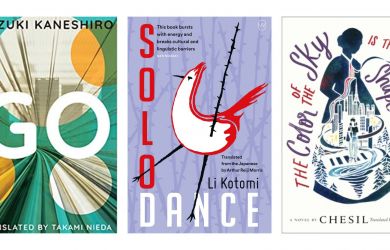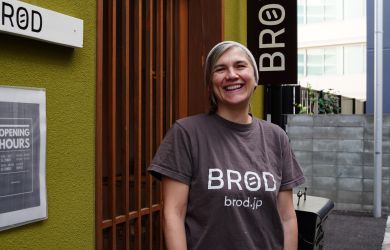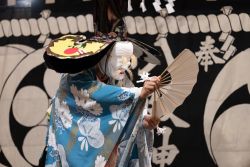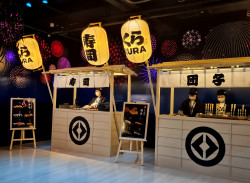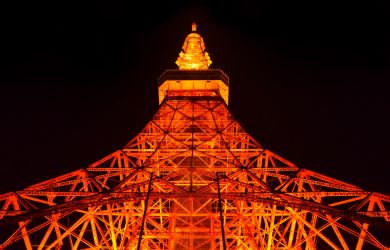
Originally published on metropolis.co.jp on November 2012

Japanese TV is often portrayed as one-dimensional slapstick comedy filled with crazy obstacle courses and ludicrous pranks. Western television producers have tried to emulate some of these Japanese entertainment shows with awful results—perhaps not realizing that most of the contestants are actually comedians who are more focused on conjuring laughs rather than completing the course or winning the game. And though the shows might seem like madness, there is in fact a very distinctive, sophisticated comedic system in action. Once you become familiar with a few comedians and tarento (celebrities), some of the intricacies will emerge. Here is our list of the top ten of shows to get started.
10. Sanma’s Super karakuri-TV
さんまのスーパーからくりTV
TBS TV: Sun, 7pm
Japanese level N3-N1
Hosted by charismatic veteran comic Sanma Akashiya (and his distinctive laugh), this 1992-born quiz show features a panel of regular and special guests. Instead of your basic Q&A format, questions are derived from pre-recorded videos. The screening video (with obligatory studio reaction box in the top corner) is paused and Sanma asks the panel a question about what will happen next. The panellists make predictions based on the audiences’ reaction to the discreetly revealed answer. Classic segments include vox pops, strange people singing songs, and a pop quiz in an old people’s home. Six points for a “nice joke” answer (naisu boke), six for an almost correct answer (oshii), and ten points for a bullseye (seikai). The winner gets a shot at the special “chance prize.”
9. Takara sagashi adventure nazotoki battle tore!
宝探しアドベンチャー謎解きバトルTORE!
Nippon TV: Mon, 7pm
Japanese level N5-N2
TORE! for short is a classic game show hosted by a supercilious animated pharaoh mask. Each week two teams of comics and celebs face off in games ranging from steering a ball bearing into a pipe hole before the walls “crush” the contestants, swinging from ropes to answer multiple choice pictograph questions and rearranging hiragana characters before being chomped by a monster. Complete with team rivalry banter, product placement and cross-promotional ads (as Japanese TV has perfected to a fine art), this is a light-hearted show with guaranteed nail-biting drama in each race against the clock.
8. mecha 2 iketeru! what a cool we are!
めちゃ 2イケてるッ!
Fuji TV: Sat, 7:57pm
Japanese level N3-N1
This variety comedy show features different segments each week, including skits, field trips, games, obstacle course challenges and pranks. Hosted by veteran duo Ninety Nine—Okamura Takashi (the wise guy) and Yabe Hiroyuki (the straight man)—this program has lasted sixteen years, which is no mean feat. Most comedians only last half a year, with newbies in constant fear of “disappearing” (kieru) from the limelight. Okamura took a break from TV for five months in 2010 after being hospitalized with depression.
7. hoko x tate
プライドに懸けた真剣対決ショー ほこxたて
Fuji TV: Sun, 7pm
Japanese level N4-N2
The title of the show (Spear vs. Shield) is a play on mujun (contradiction)—a compound made up of the kanji for spear (矛) and shield (盾). The concept is a faceoff between conflicting forces—machinery, technology, intelligence or human strength. Often the most interesting are between two companies keen to show off the quality of their product on TV. Faceoffs have included an unbreakable metal barrier versus an all-destroying crushing ball, an impenetrable vault versus the world’s best safe cracker, and an unidentifiable padded bra versus a breast implant surgeon. It’s always fun to see Japanese businessmen from opposing companies trash talking each other in honorific form (keigo) before respectfully exchanging name cards. Hosted by comedy duo Taka and Toshi, competition suspense is always enhanced by pre-battle expert forecasts and celebrity guest predictions.
6. Nep League
ネプリーグ
Fuji TV: Mon, 7pm
Japanese level N5-N1
A celebrity quiz show where two teams of five compete for a chance at the final bonus stage—a Disneyland-style ride complete with multiple-choice questions. Each week comedy trio Neptune, plus two other celebrity guests, make up one team—hence the title. Teams take turns lining up on stage to complete a round of questioning while the other team watches on in a studio room, entertaining the audience with comedic banter and sledging off the opposition. Questions are usually straightforward trivia, and sometimes even English translation, meaning viewers with intermediate Japanese ability can play along. Challenges include five individual correct answers in a row, each team member writing a hiragana character in the designated order to come up with the correct word, and kanji and English spelling problems.
5. moshimono simulation variety otameshika!

もしものシミュレーションバラエティ お試しかっ!
Asahi TV: Mon, 7pm
Japanese level N5-N2
A classic Japanese ranking show with a twist, this show has blatantly blurred the lines between corporate marketing and entertainment. But it works. Hosted by comic duo Taka and Toshi, celebs gather at a famous restaurant or food store and take it in turns to try and guess the top-ten selling menu items. The group must then eat the selected items—with the obligatory oishii—and then their rankings are revealed. Ten correct guesses mean ¥1 million. The catch is they cannot go home until they have correctly chosen and eaten all top-ten items, meaning recording can run over eight hours into the early morning light.
4. shabekuri 007
しゃべくり007
Nippon TV: Mon, 10pm
Japanese level N2-N1

Seven masters of improvisational comedy face off against celebrity guests. The designated MC, Ueda Shinya from the Cream Stew comedy group interviews guests while the remaining six comics coerce others into making fools of themselves, and make general mischief. One popular segment, called “Girigiri 007,” sees each comedian write down a controversial question which the guest may answer or not—though peer pressure means they mostly do. Past bombshells have included, “What’s the most money you’ve earned in a month?”, “Which celebrity do you most dislike?”, and “Which comedian do you find least funniest?”.
3. Lincoln
リンカーン
TBS TV: Tue, 10pm
Japanese level N3-N1One of Japan’s biggest comic duos, Downtown, feature in this variety show, with wise guy Hitoshi Matsumoto and straight man Masatoshi Hamada plying their trade since 1982. Matsumoto is the consummate performer; consistently manufacturing gags with his quick wit, charisma and aura of always being on the verge of contagious laughter. Meanwhile, Hamada has impeccable straight-guy comic timing, and relishes meting out abuse. Lincoln also features duos Summers, Kyaiin, and Ameagari Kesshtai (“suicide corps after the rain”) with past shows including segments such as riding the joke elevator, obstacle courses in giant character costumes and walking down Japan’s biggest fashion catwalk in ridiculous outfits.
2. London Hearts
ロンドンハーツ
TV Asahi: Tue, 9pm
Japanese level N2-N1

This is a no-holds-barred prank-cum-ranking show hosted by comedy duo London Boots—hence its title. Celebs agreeing to appear seem to carry the philosophy of “any publicity is good publicity.” Infamous pranks have included models tempting married comedians, music executives convincing a tone-deaf comic to change career to singer, and hidden cameras in private drinking sessions. Ranking specials place comics and celebs in order of attractiveness, for example. In one recent episode random foreigners were brought in to judge the most attractive of three teams of “women”—with one team made up of female comedians, one of transgender celebrities, and the other of male comics in drag.
1. DownTown no gaki no tsukaiya arahende!
ダウンタウンのガキの使いやあらへんで!!
Nippon TV: Sun, 10:56pm
Japanese level N4-N1
You are always guaranteed a laugh with this comedy variety show, featuring duos Downtown and Kokoriko, and solo comic Yamazaki Housei. First broadcast in 1989, the show includes challenges, stunts, role-plays, stand-up, random games, sports competitions and penalty games (batsu ge-mu). These outrageous games provide slapstick humour, but are often just a platform for hilarious jokes, banter and comedic wit. The show has even become an overseas hit with its “Silent Library” segment reaching millions online. In the segment, the five comics and celebrities draw forfeit cards (leading to the pulling of nose hairs, being bitten on the neck by a toothless old man, or having a snake put down their backs), all the while trying to remain silent. This segment later developed into the hit 24 Hour No Laughing Allowed special which now plays every New Year’s Eve.
Wise guy, eh? class rules in Japanese TV comedy
If you have hung around any Japanese kids in the last few years you will have heard the words tyu-su, yi-ha- or oppapi a lot—but you won’t find them in any dictionary. They are all made-up catchphrases of famous Japanese comics—which often go hand in hand with a silly gesture. To foreign eyes, entertainment TV in Japan—like made-up catchphrases—might appear slapdash. But all Japanese comics work within a highly evolved unique comedic framework.
Firstly, as with social and business life in Japan there is a hierarchical structure that underpins every performance. For example, all new comedians breaking in on the scene (bure-ku geinin) must kowtow to other veteran comedians—unless it’s part of their routine, in which case they’ll apologize for their impertinence after the show, and very often during it as well.
Another major dynamic is the straight guy (tsukkomi) versus wise guy (boke). This is the basis for people hitting each other on the head—it’s a comedic form of reprimanding the wise guy. The majority of Japanese comics form duos of this kind, and will have come through the ranks performing stand-up for years before breaking through to national TV.
TV shows might have up to fifty comics and celebrity guests. In the West this format would create a competitive atmosphere with guests vying for time in the spotlight. But in Japan the comics will often work in tandem for set pieces. Comedic performers, like many other groups in Japanese society, are a close-knit community bound by socio-cultural rules and etiquette. This intimacy between the hundreds –if not thousands—of well-known Japanese comedians always creates an interesting air of familiarity and drama—as well as being pretty funny.
